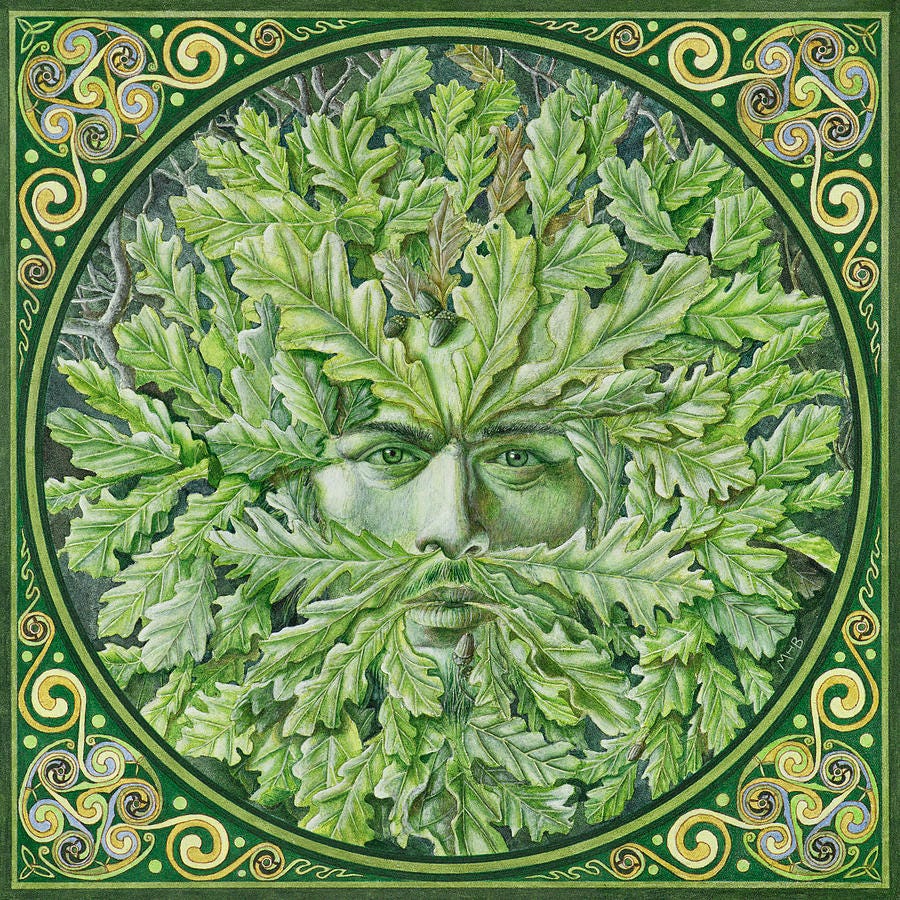Winter has passed, summer’s golden rays have come at last. The Green man now reigns supreme throughout the land.
But who is this mythical figure? You might have seen him on the corner of an ancient church or depicted on a weathered pub sign. He appears in May Day celebrations as Jack-in-the-Green. Largely forgotten by most, he waits through the centuries, in obscure corners, for us to return to him. A reminder of the spiritual understanding our ancestors held about the land’s divine connection.
The Green Man is a symbol, embodying the transformation of winter into summer, representing the death and resurrection of life and the land. It is no surprise that he is often interpreted as a nature deity, our pagan ancestors celebrated seasonal shifts through festivals such as Floralia and Beltane. How fitting, then, that during the same springtime of these festivals, the Son of God, Jesus Christ, died and rose again.
Whenever I hear Donovan’s cover of Lord of the Dance I think of the Green Man skipping through the forest like that of Tom Bombadil. For what they symbolise is, in essence, the same. The Green Man represents the sacrificial king. This is why, in The Lords of the Rings, Aragorn is crowned on the first of May, signifying civilisational renewal and the return of the Golden Age. The Green Man directs us to the heart of Christian belief: the pattern of life, death and rebirth. Standing as a reminder of mankind’s relationship with the cosmos.
The term Green Man is modern in origin, coined by Lady Raglan in 1939 in her article The Green Man in Church Architecture for The Folklore Journal. Her interest was sparked when the vicar of St Jerome’s church in Llangwm, Monmouthshire, drew her attention to a mysterious stone figure inside the church. She theorized that the Green Man was pagan in origin, an example of a surviving remnant of paganism in medieval England. What she did not realise, however, was that the Green Man was not only widespread in churches across Britain, but also found throughout Europe, having long gone unnoticed in plain sight. In much the same way, we too have become distanced from our connection with the natural world.
In England, the features of the Green Man can be seen as early as the 9th century on an Anglo-Saxon church font from Delon, Devon. However, he is more commonly found in 12th century churches, where his image aligned naturally with the Romanesque and Gothic style, which frequently incorporated elements of nature into church architecture. Green Man carvings can be found throughout medieval Europe, in Cyprus, where a series of them adorn the columns of the 13th century St. Nicholas Church in Nicosia, as well as late 4th century Green Man found in St. Abre, In St. Hilaire-le-Grand; France.
He appears in many forms, but three are especially common. The Foliate Head, completely covered in green leaves. The Disgorging Heads depicts foliage sprouting from his mouth. The Bloodsucker Head with leaves and vines sprouting from every facial orifice.
The Green man's roots run deep within Christian tradition. The Golden legend includes a tale where Seth, the son of Adam, plants seeds in his father’s mouth after his death. From these seeds grew three trees, the wood of which would later form the cross upon which Christ suffered his Passion. This powerful image represents life springing forth from death, reflecting the natural cycles of life, death, and rebirth, and affirming the supremacy of God’s creation over man. Remarkably, this interpretation closely aligns with how we understand the Green Man today. His symbolism, of death, rebirth, and the enduring spirit of nature, has remained strikingly consistent throughout the ages.
However, it’s hard not to feel a deep connection between the Green Man and the British land, Long before the term ‘Green Man’ was coined by Lady Raglan, Robert Burns captured the Green Man's spirit with his song John Barleycorn, which explored the theme of the land renewing itself against the wishes of man, signifying the dominion that nature and the cosmos has over man. Dependent on nature for our existence and flourishing, but also totally at its mercy.
They took a plough and plough’d him down,
Put clods upon his head
And they hae sworn a solemn oath
John Barleycorn was dead
But the cheerful Spring came kindly on
And Showr’s began to fall
John Barleycorn got up again,
And sore surprise’d them all
The Green Man is the guardian of the natural world, and he never sleeps. Even in the depths of winter, bulbs that have lain dormant throughout autumn begin to push their way toward the surface of the frozen soul. Snowdrops shyly appear beneath hedgerows, catkins shimmer in the pale February sunshine, and in sunlit corners, early daffodils begin to bloom. Slowly the Green man renews the land, and every man that once believed themselves above his will, in time, bow to his law.
It is no wonder that the archetype of the Green Man has been reborn in our age, when we most need him. Living in the post-industrial age, we cannot help but feel something has been taken from us, our deep kinship with the natural world. He stands as a reminder, leaf-crowned and silent, of what it means to dwell with the Lord in the land he intended for us. And so, we look to him in our own civilisational winter as a symbol of hope and renewal, that the spring of our age will come. Snow drops will blossom in the dust of what has been decayed, and the land will be resurrected once more.








Also known as Khadir who some say, walked with Moses! Check out tom cheetham!